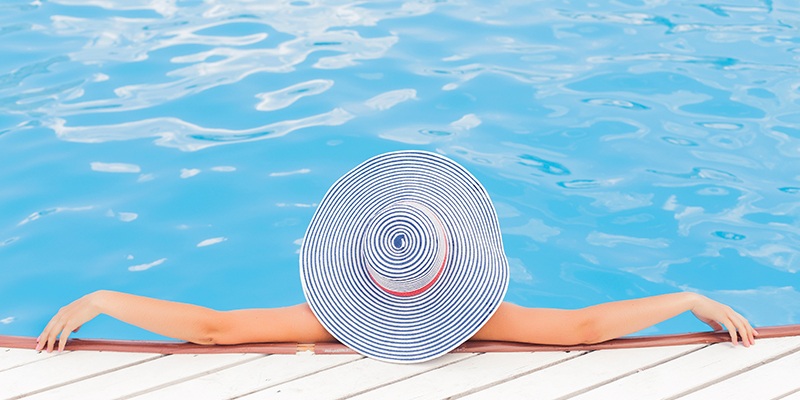If a pool has been susceptible to heavy rainfall, it is likely to have gained much dirty water and is now full of mud and other debris from gardens and other various contaminants.
Although a dirty, clouded and flooded pool is a huge inconvenience, the pool can be used soon after if it is treated promptly after the weather subsides. The following procedure is recommended to rectify flooded pools.
Step 1
Check the pump, filter and other mechanical parts of the pool system for damage. If there is any damaged equipment, see the applicable manufacturer for instructions or replacement parts
Step 2
Remove all debris from the pool. The water has probably brought in leaves and other debris from the surrounding areas. They will add large amounts of organic matter to the water, which in turn will cause issues with algae and chlorine residual. The sooner rubbish is removed from the pool; the sooner clean-up can begin.
Step 3
Use Power FlocTM to drop the clay and dust that has clouded up the pool to the bottom. Remember that overdosing Power Floc will not make the job work faster. Please consult a BioGuard® dealer for any issues
Step 4
Vacuum the debris formed from the Power Floc to waste.
Step 5
Turn on and leave on the pump/filter till water balance has been achieved. From now, much of the debris should have been removed from the water. Although still cloudy, the filter is the easiest way to clean up the water.
Step 6
Test for metals and treat accordingly. The pool water may look a lot clearer than the start, but there may be many dissolved particles within the pool that came in with the dirt and clay. If there is a residual of metals (copper/iron) it can cause permanent staining, especially when chlorine is added back to the pool. If metals are discovered in the pool, use a treatment of Pool MagnetTM to keep the metals in solution, and then add the filter aid Quick ClearTM to remove the metals from the water. Always recheck for metals after the initial treatment.
Step 7
Test for chlorine demand and treat accordingly. The flood water has washed an incredible amount of organic and inorganic material into the pool. Although most of it has been cleared out, there are still large amounts dissolved within the water. These particles can cause a huge drain on the chlorine added to the water to keep it healthy. If the pool owner has access to an Accu-DemandTM 30 testing station, it can be used to determine the exact amount of chlorine needed to add to oxidise all of these particles. If access to an Accu-Demand 30 is not available, multiple large doses of chlorine may be required to be able to hold a chlorine residual. The best starting point is to add shock doses as per the label instructions of Burn Out Extreme® until a chlorine residual can be held at 3 ppm. If there is difficulty in holding the residual for long, then double the dose until it can be held.
Step 8
Treat pool with Algaecide. The chlorine is what makes the pool healthy to swim in but as the chlorine is working at oxidising, the pool needs to be protected from algae. Follow the label dose of MSATM 2 or PolyGardTM for the treatment of a heavy infestation. This defends the pool from algae whilst the chlorine is working at oxidising and killing bacteria. Once a good chlorine residual has been achieved, go back to a maintenance dose of algaecide.
Step 9
Manage chlorine residual with Optimiser®. The most important part of bringing a pool back to its former glory is to get proper chlorine residual. Optimiser gives the water a huge advantage by making the chemicals in the water more efficient and preventing algae from growing. As algae grows, it uses up the chlorine in the water; the only solution is to add more chlorine. This can be a vicious cycle. The added benefit of using Optimiser is that it also conditions the water, making the water much gentler on hair and skin.
Step 10
Use a clarifier. At the same time as Step 9, a clarifier can be added to the water. PolysheenTM or Super Clear Clarifying TabsTM are perfect for this scenario. By now the water should be holding a chlorine residual so that the filter can be utilised to collect dead algae and other oxidised organic waste.
Step 11
Manage the water balance. The water should be tested again by a BioGuard Approved Retailer. The chemicals just added to recover the pool will have had an effect on the water balance. This is because the pool had just been flushed with new (dirty) water. The water needs to be balanced again as it is the most important step to keeping the pool healthy, sparkling, clean and inviting.
Step 12
Use a clarifier one last time when the water is balanced. Although the water may look beautiful and fresh, the addition of one last clarifier — Polysheen or Super Clear Clarifying Tabs — will really bring the sparkle back into the water.
The above information is supplied by BioLab Australia Pty Ltd / Chemtura New Zealand Ltd and represents its best interpretation of available technical information at the time of preparation. The sole purpose is to supply factual information to our customers. It is not to be taken out of context or used as support for any other claim not made herein.

